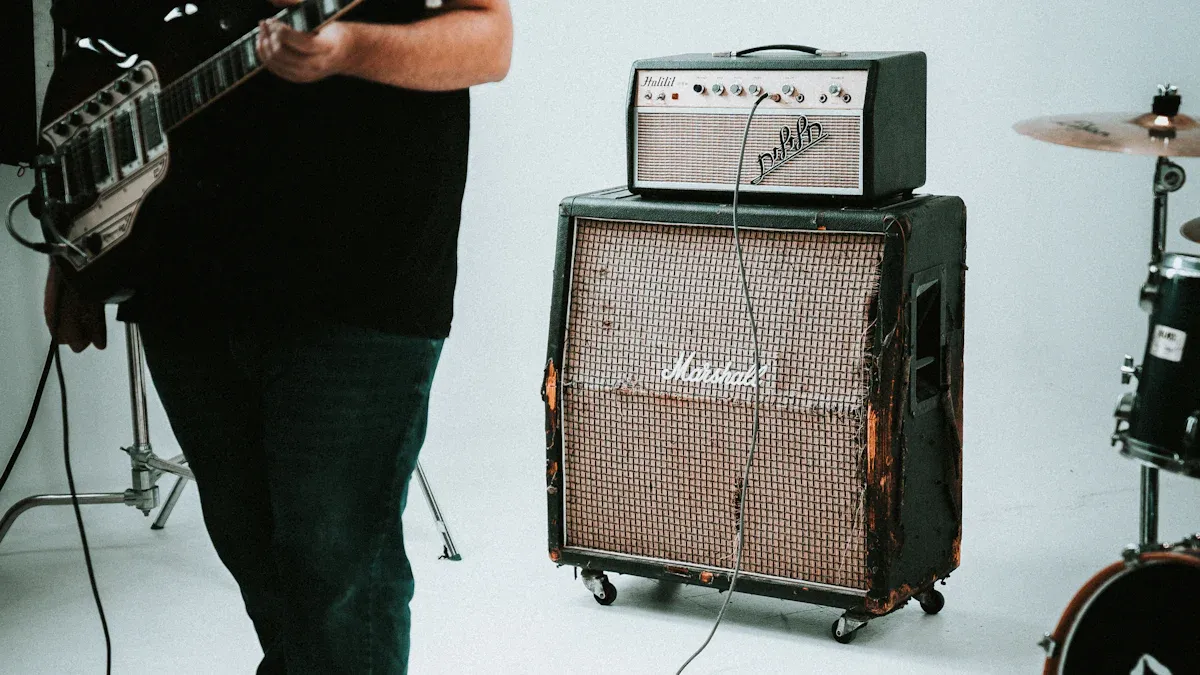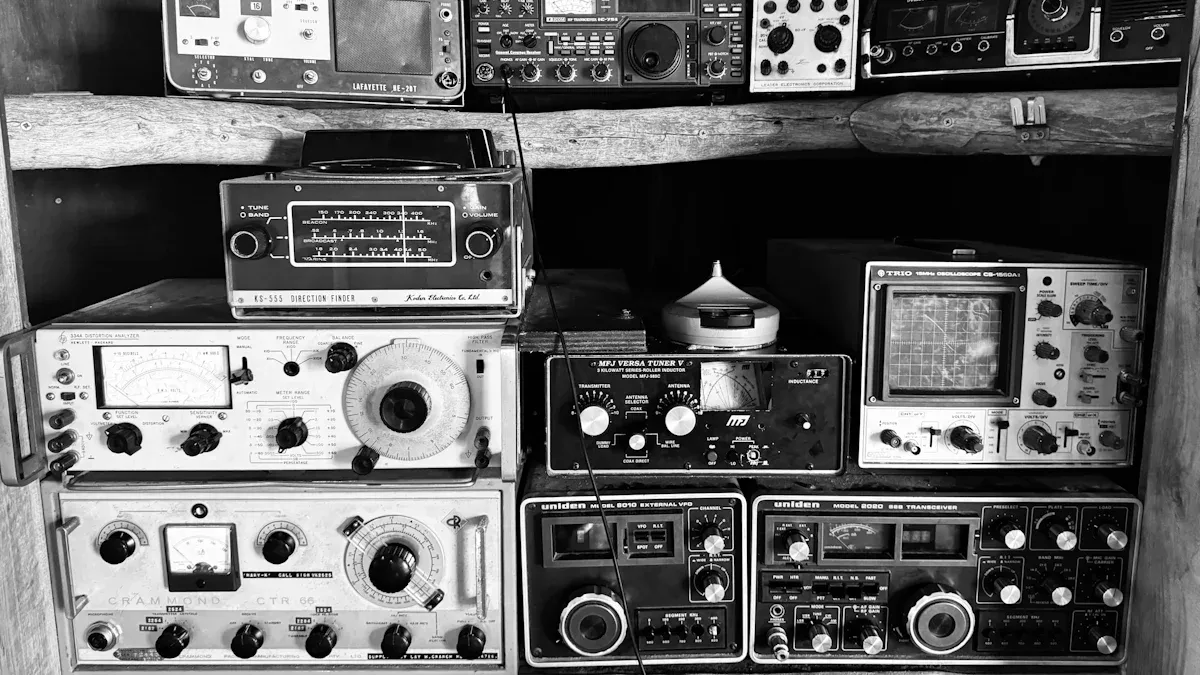

When you look at audio amplifiers, you will notice two main types: tube amps and solid state amps. Tube amps use vacuum tubes, while solid-state amps use transistors. This simple difference changes your audio experience in big ways. Tube amps often give you a warmer sound, but solid-state amps offer more reliability. You may find solid-state amplifiers easier to use and maintain. Your choice shapes how you hear music and how you interact with your audio equipment. Think about what kind of audio experience you want before picking an amplifier.
When you use tube amplifiers, you rely on vacuum tubes to boost your audio signal. These tubes act like small light bulbs that control the flow of electricity. You will notice that tube amplifiers often run hot because the tubes conduct current all the time. This design gives you a classic, vintage sound that many people describe as warm and musical. Tube amplifiers can produce unique harmonics, especially when you turn up the volume. These harmonics add richness to your music.
You can see how tube amplifiers perform in the table below:
| Aspect | Details / Metrics |
|---|---|
| Class A Power Output | ~20 watts using a pair of 6L6 tubes |
| Class AB Power Output | ~50 watts using the same pair of 6L6 tubes, with higher plate voltage and deeper bias for efficiency |
| Harmonic Distortion | Produces 2nd, 3rd, and 4th order harmonics, creating a warm sound |
| Tube Matching Standards | Tubes matched within 1 mA plate current and 100 microohms transconductance |
| Output Transformer Role | Matches tube impedance to speaker, adds sustain and musical quality |
You may find that tube amplifiers need more care. Tubes wear out over time, so you will need to replace them. The output transformer also shapes the sound and can affect high frequencies. Many fans of tube amplifiers enjoy the hands-on experience and the unique audio character.
Solid-state amplifiers use transistors instead of vacuum tubes. These transistors switch and amplify your audio signal with great efficiency. You will notice that solid-state amps stay cooler and last longer than tube amplifiers. They also weigh less and take up less space, making them easier to move and set up.
Here is a table showing how solid-state amplifiers perform:
| Performance Metric | Solid-State Amplifiers (GaN, Si LDMOS) | Traditional Vacuum-Tube Amplifiers |
|---|---|---|
| Output Power (Continuous) | Up to 500 W in compact enclosures | 2.0 to 3.3 kW at X-band frequencies |
| Efficiency | Up to 50% | Lower, with more heat |
| Size and Weight | Smaller, lighter, easy to transport | Larger, heavier |
| Cooling | Forced-air cooling, less complex | Needs more extensive cooling |
| Extra Features | Built-in monitoring, protection, remote control | Some modern tube amps have controls |
Solid-state amplifiers give you reliable audio amplification. You get clear, accurate sound with less maintenance. Many solid-state amps include features like remote control and built-in protection. You can trust these amplifiers for daily use, whether you listen at home or on stage.
Tip: If you want a low-maintenance, portable amplifier with consistent performance, solid-state amps may suit you best.

When you listen to tube amplifiers, you often notice a warm sound that feels rich and musical. Tube amps create this effect by adding even-order harmonic distortion. This type of distortion gives you a warm distortion sound that many people find pleasing. Tube sound is famous for its smoothness and natural flow. Some tube amps, like the Octave Jubilee Mono SE, offer a natural warmth and a smooth midrange. You may hear a thrilling liquidity in the audio, which makes music feel alive.
Solid-state amplifiers work differently. They use transistors to amplify the audio signal. Solid-state amps usually produce odd-order harmonic distortion. This can make the sound more precise but sometimes less warm. Some solid-state amplifiers, such as the Benchmark AHB2, deliver very low distortion and noise. You get a clean and clear sound with these models. The tonal balance often feels lighter than with tube amplifiers.
Here is a table that compares the tonal qualities of different amplifier models:
| Amplifier Model | Type | Measured Distortion & Noise | Tonal Qualities & Subjective Impressions |
|---|---|---|---|
| Feliks Audio Arioso | Tube | Transparent, no added warmth or fuzziness | Recovers low-level information; more transparent than solid-state Parasound Halo A 21+; tonal balance not warmer or blurrier. |
| Octave Jubilee Mono SE | Tube | Low distortion and noise; high source impedance | Natural warmth, smooth midrange, thrilling liquidity; low noise; bass tight but slightly less impactful than solid-state. |
| Benchmark AHB2 | Solid-State | Very low distortion and noise; high S/N ratio | Clarity, transparency, tonal balance lighter than tube amps; dense detail but lighter tonal weight; clean and clear sound. |
| darTZeel NHB-108 model two | Solid-State | Distortion ~0.1%, predominantly second harmonic | Organic flow, nonmechanical sound; reveals details without harshness; subjectively musical and pleasing despite solid-state. |
You may prefer tube amplifiers if you want a sound signature that feels warm and musical. If you like good clean sounds, solid-state amplifiers might suit you better.
You will notice that solid-state amplifiers stand out for their clarity and accuracy. These amps use transistors to deliver audio with great detail. Many listeners describe the sound as clean and precise. Solid-state amplifiers often give you a wider soundstage and imaging, which helps you place instruments and voices in space. You can hear every detail in the music, making the experience feel real.
Tube amplifiers offer a different experience. They add subtle harmonic distortion that can smooth out harsh recordings. This makes the audio sound more musical and less clinical. Some people say tube amps can sound muddy or overly distorted, but others love the richness and depth. Tube sound often brings out the emotion in music, even if it is not as accurate as solid-state.
Solid-state DACs and amplifiers are known for accuracy, precision, and clarity.
Some listeners find solid-state sound sterile or clinical.
Tube DACs and amplifiers add warmth, richness, and musicality.
Tube amps can smooth harsh recordings but may sound muddy to some.
The choice between tube and solid-state often depends on your personal taste.
If you want the cleanest audio possible, solid-state amplifiers deliver. If you enjoy a more relaxed and musical sound, tube amplifiers may be your choice.
Dynamic response describes how quickly an amplifier reacts to changes in the music. Tube amplifiers often have a unique "sag" when you play loud or fast passages. This sag gives the audio a softer attack and a more forgiving feel. Many musicians and listeners enjoy this effect because it adds character to the sound.
Solid-state amplifiers respond with speed and precision. You get a solid and immediate reaction to every note. This makes the audio feel punchy and energetic. Solid-state amps keep the sound tight, even at high volumes.
Here is a table that shows some measurements of dynamic response:
| Measurement Type | Tube Amplifiers (e.g., Mastersound SET 300b) | Solid-State Amplifiers |
|---|---|---|
| 2nd Harmonic Distortion | 0.2% to 0.8% | Slightly less than tube amps |
| 3rd Harmonic Distortion | 0% to 0.2% | Slightly more than tube amps |
| Frequency Response Deviation | About 1-2 dB variation in different frequency areas | Similar but with different output impedance effects |
| Overall Distortion Level | Generally under 1% | Generally under 1% |
You may notice that both tube and solid-state amplifiers keep distortion levels low. However, the way they handle dynamics and harmonics shapes the overall sound signature. Tube amps give you a softer, more musical response, while solid-state amplifiers provide a fast, clean, and controlled sound.
